Mating
Just How Important Is Breast Size in Attraction?
Across cultures, men do not consistently prefer large breasts.
Posted January 14, 2020 Reviewed by Matt Huston
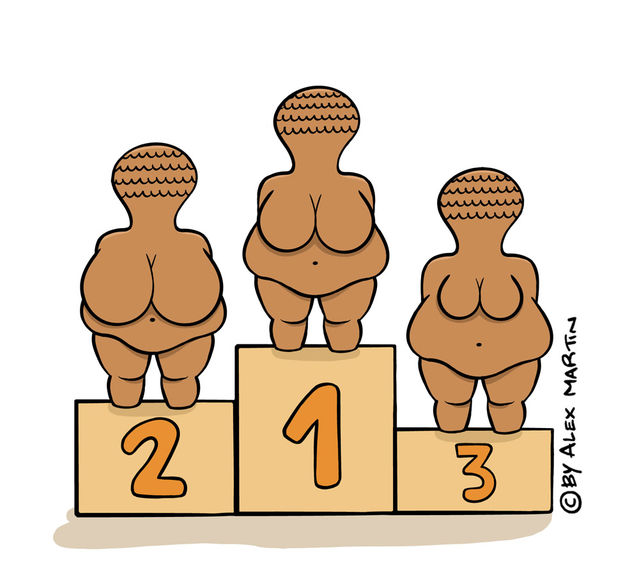
Supposedly, consistent male preferences for a particular breast size feed claims that they reflect evolutionary adaptation. To make this plausible, it must be shown that reported attractive features provide cues to women’s potential reproductive capacity or health. But any preferences may be largely or exclusively culturally determined, perhaps reflecting particular notions of female beauty peddled by Western media.
Do men prefer large breasts?
Since the 1960s, many studies have assessed the attractiveness of women’s breasts, notably regarding the size. One early contribution by Jerry Wiggins and colleagues (1968) tested men’s preferences for breasts, buttocks, and legs using simple, nude female silhouettes.
Ninety-five male undergraduates rated paired images with different sizes of those body regions. The main aim was to identify personality traits associated with preferences, but some interesting baseline information emerged. Although men rated large breasts as more attractive than small ones, moderate breast size was preferred over the largest presented.
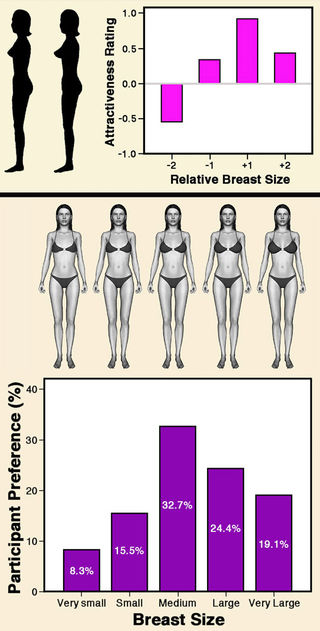
Subsequently, published attractiveness ratings for breast size yielded conflicting findings, with preferences for large, medium, or even small breasts reported. Overall, however, men predominantly rated medium-sized breasts highest.
A prime example is a 2013 paper by Viren Swami and Martin Tovée, reporting on a sophisticated study using rotating 3D test models, which yielded ratings close to the original findings of Wiggins and colleagues. Choosing between five different breast size categories, a third of men rated medium as most attractive. Only a quarter preferred large breasts and just one in 10 preferred very large breasts.
To identify social influences, Swami and Tovée studied British white men in a London community. They found that preferences for larger breasts were significantly associated with greater tendencies towards "benevolent sexism," objectification of women, and hostility towards them.
The all-important cross-cultural perspective
Only cross-cultural studies can reveal responses that are consistent regardless of social norms and may perhaps have an evolutionary foundation. A 2010 paper by Barnaby Dixson and colleagues explicitly addressed this key issue of variation across cultures. Using a questionnaire, preferences for women’s breasts in test images were assessed for over 200 men in New Zealand, Samoa, and Papua New Guinea.
One clear finding was that men in Papua New Guinea showed a greater preference for larger breasts than New Zealanders, while Samoan men were intermediate. Intriguingly, preferences differed between unmarried and married men. In New Zealand, bachelors predominantly preferred a medium size while married men favored large breasts.
Differences between cultures also emerged. Although Samoan men showed a distinction between unmarried and married men like New Zealanders, they more strongly preferred larger breasts overall. Contrastingly, unmarried and married men differed little in Papua New Guinea; both predominantly preferred large breasts.

Taking a broader approach, a 2017 paper by Jan Havlíček and colleagues assessed men's preferences for both the size and shape of women's breasts in four cultures—Brazil, Cameroon, the Czech Republic, and Namibia. Breast firmness declines with age and successive births, so the authors proposed that—whereas breast size in young women indicates potential fertility—breast firmness might indicate residual fertility thereafter. They hypothesized that, across cultures, men would be expected to show preferences for both breast size and firmness (which affects shape).
Tests conducted with male raters used two sets of images, one with differing breast size and the other with various degrees of breast firmness. Although size preferences varied, most raters preferred medium breasts, with large following, providing cross-cultural confirmation that men generally prefer breasts of intermediate size. Across all four cultures, Havlíček and colleagues identified a consistent preference for firm breasts, supporting the notion that shape indicates residual fertility.
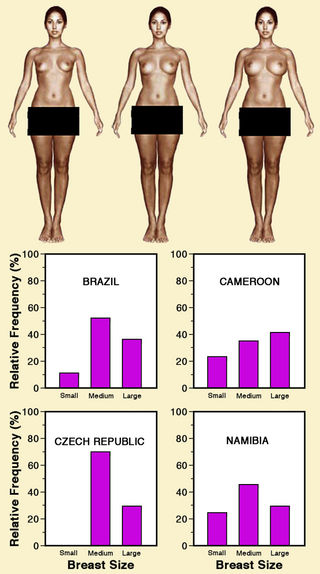
Breast size and hormones
Complementary evidence comes from breast size in relation to hormone levels. In 2004, Grazyna Jasieńska and colleagues presented results from monitoring hormones over a complete menstrual cycle for over 100 Polish women aged 24-37 years. They found a small but significant positive association between large breasts and the female hormone oestradiol (the dominant oestrogen).
Women with both large breasts and narrow waists had oestrogen levels about a third higher than those with other combinations. This difference might allow men to assess female reproductive potential. Research published in 1996 by Susan Lipson and Peter Ellison revealed that in women aiming for pregnancy, oestradiol levels were significantly higher in cycles where conception occurred. Citing this, Jasieńska and colleagues proposed that in women with large breasts and narrow waists, higher oestrogen levels may indicate a substantially higher likelihood that they will conceive.
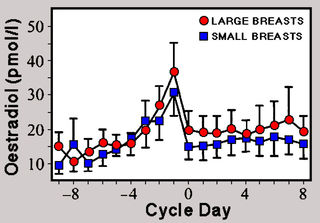
A decade later, Rachel Grillot and colleagues reported findings from follow-up research into anatomical and hormonal indicators of women’s bodily attractiveness. These authors monitored hormones across one or two menstrual cycles of 33 female students averaging 19 years in age, going beyond Jasieńska and colleagues in two crucial respects: First, students of both sexes rated anonymized photographs of the participants’ own bodies to assess attractiveness. Second, the Body Mass Index (BMI; body weight divided by height squared) was calculated to assess interactions with attractiveness.
Contrary to Jasieńska et al., Grillot and colleagues found no significant correlations between average hormone concentrations and breast size. However, their sample size was markedly smaller, and test subjects were a decade younger.
Yet one significant finding did emerge: Attractiveness was negatively correlated with BMI. When Grillot and colleagues allowed for this in analyses, a positive association between attractiveness scores and oestradiol levels was revealed. Ultimately, then, Grillot and colleagues did reach a result resembling that of Jasieńska and colleagues.
Regardless of sample differences, these two studies of female attractiveness in relation to hormone levels share a notable weakness in lacking effective cross-cultural comparison.
Surgical modification of breast size
Around the world, many women seek cosmetic surgery to modify breast size. Reportedly, the greatest demand exists in Brazil, but such interventions are very common elsewhere. The 2018 Plastic Surgery Statistics Report from the American Society of Plastic Surgeons notes that breast augmentation has been the top-ranking cosmetic procedure in the USA since 2006.
For 2018, a total of 313,000 procedures were recorded, up 4 percent over 2017. Note, however, that cosmetic breast modification can also involve reduction. In both 2017 and 2018, approximately 43,600 reductions for aesthetic reasons were recorded. But augmentations were seven times more common.
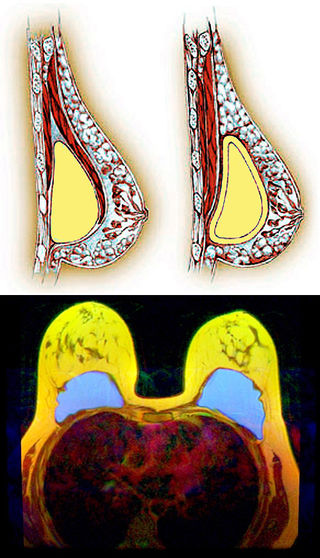
A 2003 paper by Elizabeth Didie and David Sarwer presented results of a questionnaire-based survey of two dozen women who decided to undergo cosmetic breast augmentation. Comparison with a similar number of women not seeking surgery confirmed results of previous studies: Candidates for augmentation felt greater dissatisfaction with their breasts.
Yet women in the two groups did not differ with respect to overall dissatisfaction with their body images or awareness of sociocultural influences. Overall, women requesting augmentation were seemingly motivated primarily by their own feelings about their breasts. Direct or indirect external influences, such as expectations of romantic partners or socio-cultural representations of beauty, were less important.
Take-home messages
As the previous blog piece reported, a woman’s capacity for milk production has no connection with breast size before pregnancy. What matters is the increase in size during pregnancy. Any evolutionary explanation for men’s responses to a woman’s breasts in terms of reproductive capacity must hence lie elsewhere.
However, one key finding from a host of studies of female breast size is that men predominantly prefer medium size, not large. This bears directly on the widespread demand for cosmetic breast augmentation. The major motivation seems to be a woman’s own perception of her body image rather than male preferences.
Various attempts have been made to link male preferences for female breast size to fertility indicators with some evolutionary function. But such preferences are too inconsistent across cultures to permit clear recognition of an evolutionary basis. Moreover, multiple complicating factors, such as BMI, breast firmness and shape, features of the nipple and surrounding areola, and men’s marital status preclude any simple explanation.
References
American Society of Plastic Surgeons (2019) 2018 Plastic Surgery Statistics Report (pp. 25). Arlington Heights, IL: American Society of Plastic Surgeons.
Didie, E.R. & Sarwer, D.B. (2003) Factors that influence the decision to undergo cosmetic breast augmentation surgery. Journal of Women's Health 12:241-253.
Dixson, B.J., Grimshaw, G.M., Linklater, W.L. & Dixson, A.F. (2011a) Eye-tracking of men’s preferences for waist-to-hip ratio and breast size of women. Archives of Sexual Behavior 40:43-50.
Dixson, B.J., Vasey, P.L., Sagata, K., Sibanda, N., Linklater, W.L. & Dixson, A.F. (2011b) Men’s preferences for women’s breast morphology in New Zealand, Samoa, and Papua New Guinea. Archives of Sexual Behavior 40:1271–1279.
Grillot, R.L., Simmons, Z.L., Lukaszewski, A.W. & Roney, J.R. (2014) Hormonal and morphological predictors of women’s body attractiveness. Evolution & Human Behavior 35:176-183.
Groyecka, A., Żelaźniewicz, A., Misiak, M., Karwowski, M. & Sorokowski, P. (2017) Breast shape (ptosis) as a marker of a woman's breast attractiveness and age: Evidence from Poland and Papua. American Journal of Human Biology 29,e22981:1-8.
Havlíček, J., Třebický, V., Valentova, J.V., Kleisner, K., Akoko, R.M., Fialová, J., Jash, R., Kočnar, T., Pereira, K.J. Štěrbová, Z. Corrêa Varella, M.A., Vokurková, J., Vunan, E. & Roberts, S.C. (2017) Men's preferences for women's breast size and shape in four cultures. Evolution & Human Behavior 38:217-226.
Jasieńska, G., Ziomkiewicz, A., Lipson, S.F., Ellison, P.T. & Thune, I. (2004) Large breasts and narrow waists indicate high reproductive potential in women. Proceedings of the Royal Society of London B 271:1213-1217.
Lipson, S.F. & Ellison, P.T. (1996) Comparison of salivary steroid profiles in naturally occurring conception and non-conception cycles. Human Reproduction 11:2090-2096.
Swami, V. et al. (2010) The attractive female body weight and female body dissatisfaction in 26 countries across 10 world regions: Results of the International Body Project I. Personality & Social Psychology Bulletin 36:309-325.
Swami, V. & Tovée, M.J. (2013) Men's oppressive beliefs predict their breast size preferences in women. Archives of Sexual Behavior 42:1199-1207.
Wiggins, J.S., Wiggins, N. & Conger, J.C. (1968) Correlates of heterosexual somatic preference. Journal of Personality & Social Psychology 10:82-90.




